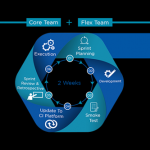Keeping an eye on the horizon in the testing world is an important part of staying in the game. Hans is no stranger to looking to the future with eyes wide and ears open. His expertise is what makes Hans valuable at the STARWEST Expo, which he recently delivered two talks to.
STARWEST is one of the most respected conferences to date and longest-running conference on software testing and quality assurance. This year’s event week featured over 100 learning and networking opportunities, covering a wide variety of some of the most in-demand topics.
With such a variety of fresh ideas to explore, we decided to catch up with Hans and enquire about what he think are the up and coming topics to pay attention to.
1. How do you think Agile and Devops will develop in 2017?
From what I’m seeing DevOps, in particular CI/CD, is getting more attention these days than Agile. The distributed version tracking system Git continues to change the landscape, and drive good workflows for system development. This includes distributed models, as alternatives or additions to methods like Scrum. Organizations like our own are learning from the open source community how to best produce stable software and control its quality, including in projects where team members are not co-located. Our methods and practices, and our Services organization, are well positioned to effectively support the many variations in workflows we are seeing in the market.
2. How many STARWEST conferences have you managed to attend?
Quite a few. I’m doing Star and some other Techwell conferences since 1998. As far as I can tell I have done 16 STARWEST conferences.
3. Did you notice any trends starting to gain momentum in automation?
Definitely. The field is undergoing major changes. The main ones obviously being Agile and DevOps. This is actually helping the ideas presented in my talks move forward very well.
4. What did you enjoy most about this conference? Why?
Meeting and talking with the delegates, hearing about their challenges and their own ideas and solutions. It is also great to see other speakers again that I have got to know over the years.
5. What is the atmosphere like, and how has it changed/grown from the first one you attended (if at all)?
The atmosphere is great, and has in fact not changed much. It is very open and all about sharing ideas and experiences.
6. What was the best feedback you received about your talk?
I get a lot of feedback during the conference. For me the best response is if people say they will use the ideas from the classes into their own practice, meaning that what was presented really made a difference.
7. What do you think is the most important part people took away from each talk?
For most of my talks that would be the importance of good test design to make automation successful. In my view automation is not as much a technical challenge as it is a test design challenge. This is not a common message, but it is the basis of our Action Based Testing (ABT) method. The idea is to divide tests into modules, and to develop them as a sequence of keyword-driven “actions”.




















